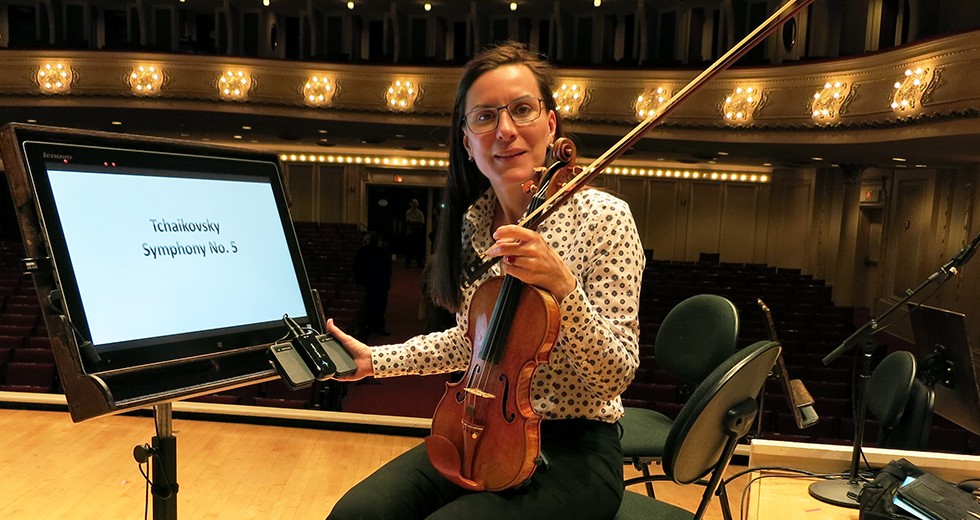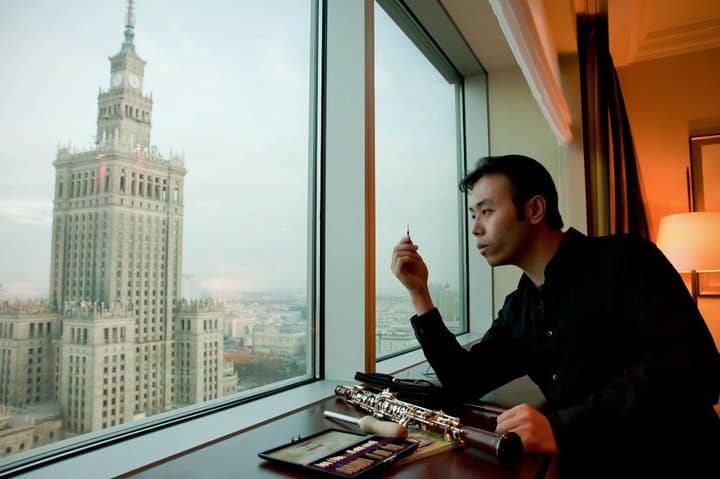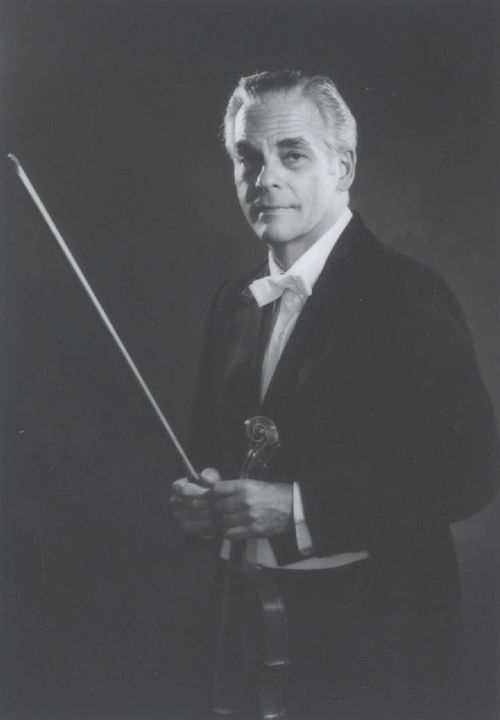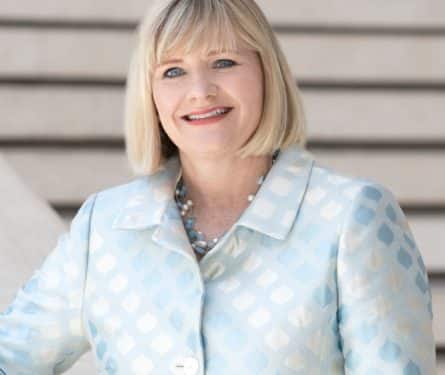No more crumpled sheets as German orchestra takes tablets
NewsFrom last night, the Stuttgart Chamber Orchestra became the first in Germany to perform without a scrap of paper on stage.
All players have been issued with electronic devices.
‘The use of tablets not only gives us access to the entire sheet music library at any time,” said Markus Korselt, artistic director. ‘It’s also easier to use, because you no longer have to turn pages by hand, you just use the foot pedal.’






Not to mention the possibility of very easily editing the sheet music, revising bowings, and adding various markings. It’s a worthwhile investment, no doubt.
What about an orchestras vast library, especially if one is in a historically famous orchestra, where markings from the “Greats” have been put in! (Yes. The conductors from over fifty years ago.) No crumpled manuscripts here. And personal annotations from players in the past. Many parts contain wonderful drawings by past players and it’s a little bit of magic, a story and connection to past players. Modern doesn’t always mean better, but it seems the younger generation don’t give a toss for tradition and history, they are too busy with their electronic devises.
All the more reason to make it electronic — they can have access to those markings if the librarian includes them in the parts.
The most advanced solution is the ADiS Music solution. I can give you more information through PM.
Is that a photo from Orchestra Hall in Chicago?
Yes. And she has problems with her electronic display very rarely. But sometimes.
It’s definitely not the Stuttgart chamber orchestra or a member of it ..: unless I don’t know my colleagues 😉
Yes, that’s Orchestra Hall, Chicago. She is Alison Dalton, and began using a computer screen years ago due to vision problems. An excerpt of her bio from the CSO website states:
“After thousands of concerts and a bout with cancer, Dalton experienced a scotoma in her central field of vision. In 2013, this persistent white dot suddenly brightened during a rehearsal, disrupting the flow of her rapid note reading. While on medical leave, she chased a diagnosis, worked with scientists devising a unique adaptation for sheet music display and began training her eyes to compensate for the scotoma by focusing around it.”
More here:
https://csosoundsandstories.org/alison-daltons-vision-cso-violinist-innovates-as-her-eyesight-evolves/
I made a post on LinkedIn about the ADiS Music solution and more particularly the ability to help musicians with sight issues. I am available through MP on m.collin@adismusic.com to share more information about what we developed.
Yes .. and I was just about to post a comment until I read yours. It should be identified as such, the home of the CSO. Mr. Labrecht should have addressed that.
Oh that’s bad. How will conservatory grads pay off their student debt now that they can’t make a living turning pages for soloists?
In all my years of playing from orchestral material (in ze Vaterland) I was never confronted with “crumpled sheets”.
Der not Ze ?
On the other hand a hacker could, a la the Marx Brothers, replace the opening pages of the the Mahler Fifth with Take Me Out to the Ball Game. (And the only person capable of capturing it on video is that jerk in the fifth row who refused to turn off his smart phone.)
But will Mrs. Claypool still agree to fund the next year’s season?
Wouldn’t that be awesome though.
Good luck. While there are many positives about using a set up like this, I found using my iPad that now I had to carry a special stand to hold it, lug around the footpad, spend too much time scanning the sheet music to save on the device, make sure the batteries are always fully charged, don’t lose the expensive stylus and other negatives. Sometimes the footpad loses contact with the iPad creating a panic when a page turn in coming up. And at least two players found the footpad cumbersome and in the way: timpani and harp who already have plenty of pedals to keep track of. It is very convenient to have all the repertoire for three orchestras and my chamber group on one device for sure. Maybe if I were 40 years younger I would be more appreciative, but for now old-fashioned paper and pencil are just fine. Much lighter and much less expensive, too.
And speaking of pedals, what’s an organist to do with that setup?
That’s a very good point. There is an (iOS) app that will automate page turning without a pedal, or using recordings, and I have used that at the organ on occasion for accompanying anthems, which always have seem to have awkward page turns.
Phenometurn, for those interested in pedal free page turns. https://apps.apple.com/in/app/phenometurn/id1602992178
People with busy feet can touch the screen to turn pages.
I’ve seen organist use 2 pads at the same time since using your feet is impossible. Also, they can swipe the screen to turn the page.
It’s not necessary to lug around a special stand. An iPad fits on a regular music stand. People with busy feet can touch the screen to turn pages.
Hello J. Barcelo.
All the issues you are describing are issues we noticed about 10 years ago.
We, ADiS Music, developed an awesome solution including devices, software and scores.
Bluetooth link between the device and the pedal may make the system unstable and it is not what you want when you have to scroll the pages.
With ADiS, you don’t have any pedal.
The battery also means weakness of the system because you won’t never master the charge. Furthermore the charge depends on the age.
I can give you more information about our solution through MP on m.collin@adismusic.com.
What do we then do with all those little pencil notes we need to do during rehearsals? Things like watch the conductor. Or play real soft. Or don’t drown the clarinets the clarinets
Or the fun of seeing a part that has survived in the orchestra for 40+ years with notes from long retired musicians that say things like, “the conductor’s tempo here is idiotic!”
You write them onto the iPad. They are saved in an electronic layer that can be switched on and off. You can also use color, enter text, select proper music notation, and use translucent highlights in many colors.
As usual, today’s “Artistic Directors” are not the ones who play in the orchestra and asked to turn pages while performing. According to them, they think that it’s always “easier to use” while THEY sit behind a desk, (so to speak), and let others play.
And yes, these Directors are paid to “think”. Their latest fad is to imagine a solution to a problem that really never was one to begin with, until technology came along.
If all of the musicians agree to using such devices, then more power to them. But how many of them ever took a course in “Learning how to play with a tablet” during their education?
Many surprises await them!
At the mention of crumpled sheets, I wondered if La Emin had taken up composition.
With respect to page turns in the orchestra where one string player has to drop out to turn the page, many of those could be avoided with proper music publishing techniques, i.e., aligning the notation so that rests occur in measures immediately preceding or just after a turn. I see way too much poor notational planning in modern computer generated parts; more so than in older engraved parts, not to mention a current general notational laziness in the placement of accidentals, orientation of rests in compound triple meters, for example. Many contemporary composers seem to lack fundamental musicianship skills when it comes to notation of their music.
Speaking as a pianist who plays a lot of music by living composers and as a typesetter who assembles scores and parts, I agree completely (although it should be acknowledged that — unlike in much orchestral music, where there usually some rests to be found even in string parts — there are quite a few situations in pianoforte music where an awkward page-turn is unavoidable… even *with* fold-out pages). The sloppiness manifested by many composers nowadays (and not just the younger ones) is incredible.
As for the topic at hand, there have been several articles and threads in Slipped Disc over the past several years, which discuss the arguments in detail. Personally, I think that paper is better, for many of the reasons articulated in threads such as https://slippedisc.com/2020/02/barenboim-gives-backing-to-escores/
Do they use green energy to charge the thing? This fad will never replace those crumpled old sheets.
Is this really progress? Granted, no more page turning and perhaps you can hook them up so that when the concertmaster changes his bowing it is immediately transcribed to the other stands, saving much time. On the other hand how do you add fingerings? Many players need to add some helpful fingerings, especially in technically demanding works. Another personal touch superceded by technical efficiency.
You write fingerings, comments, corrections, really anything, into the iPad. This information is saved in an indepent layer.
Pedants’ Corner: Superseded, not superceded.
Thanks, Colin.
I saw Boston Brass use them for the whole library a few years ago. It is a lot lighter than 5lbs folders on the stands with the parts placed who knows where, and since they change setup per piece the players have access to their parts on any stand.
No more crumpled sheets, it says: I thought for a minute that they were all going to be given steam irons.
And just like that…. The viola players will progress….
I like to move my feet around just a little during a performance of long haul like works like Rite of Spring or Mahler 5. etc. What happens if I accidentally put my foot on page turning device (and haven’t realised) or what if I have Tourette’s foot and and turn several pages into next movement.? I won’t sleep tonight worrying about this dystopian page turning nightmare scenario.
ADiS Music developed an awesome solution including devices, software and scores.
We don’t have any pedal.
I would enjoy you to sleep tonight.
You can email me to get more information.
m.collin@adismusic.com
Think of the energy used in manufacturing and charging.
What’s Plan B when “technical difficulties” occur?
Many chamber music musicians in the NY area are now using them in concerts.
I have a few questions about how this works, if anyone knows the answers. I suppose for public domain works the orchestra can download PDF parts for free, but what about for newer works that are under copyright? Do they have to rent hard-copy parts from the publishers, and then do the publishers require that they delete the files after the performances? Or are they able to order PDF copies of parts from some publishers now?
PDF is not the solution at all.
PDF is like an image and the device won’t ever know about you score and the musical content.
ADiS Music developed an awesome solution including devices, software and scores.
I can share more information through MP on m.collin@adismusic.com
Will the orchestra provide annual eye check for free? And if surgery is needed after some years, is it issured by the orchestra as employer?
When I think about how “lag-gy” and unreliable my tablet connection is during high volume bandwidth use on the network, I would be afraid to rely on this for a concert.
The music is stored on the tablet, no network connection needed at the time you are playing.
Wifi is not the solution because of Wifi pollution in concert halls.
The audience is the main issue with hundreds of cellular phones.
You can get more information through MP on m.collin@adismusic.com
Perhap’s the players themselves will soon be replaced by tablets,then the audience, no more coughing, and finally the conductor’s, no more ego.
Poor old Ulrich Hans and Ottaviano Petrucci must be turning in their graves.
If this is progress, then so be it, for those who can find it useful and successful.
For the rest of us sheet music, a 3B pencil and eraser, and a candle or two in case of power outage will do.
Good luck.
I hope to hell they don’t have a power cut!
Things that you don’t write down yourself are not realised. Old didactic problem in the age of digitisation.
While using tablets instead of sheet music has some pros, it introduces a whole box of cons as well.
The only major advantage of tablets (with pens) over traditional sheet music I found is for the traveling musician. But not even for conductors. The tablets are too small for most scores, and one big enough would be too heavy for traveling.
Also referencing a certain section quickly, no matter how savvy you are with the tablet and it’s software, can be cumbersome compared to physical paper. Simply grabbing a fat score at the side and going by the distance on the side, relative to the position of the section you want to find, is something a tablet doesn’t do.
That’s why they’ll be soon printing everything out. Such a silly idea.
Does anyone know what this wide tablet is?
I play in a variety of non-optimal venues, and greatly prefer playing from a tablet (which I assume to be an I-PAD, like the one I usually play from). When lighting is poor and old sheet music has developed a brownish-gray coloration, it can be hard to read. Also, if too much editing has been done too aggressively, it can be hard to distiguish “current” markings from old “dreck”.
The only really unfortunate thing with this particular device is: the I-PAD won’t finish turning on (i.e. finish “coming up” to display the music) when it doesn’t have access to good WiFi.
Within a serious orchestra, the use of digitized music (with different “layers” of edit marking stored inside the files) allows principal players to review the markings of ALL previous editors – and that is possibly also beneficial for scholarship research purposes.
You can email me through m.collin@adismusic.com for more information about our solution to avoid the issues you are mentioning.
Librarian of a major orchestra here. I am not convinced about substituting orchestra materials with tablets for several reasons:
1. copyright issues
2. converting a library in digital format is a major chore needing a lot of time and a lot of people
3. consumer grade tablets do not look reliable enough for everyday orchestra use (those connectors are too tiny, these cables are too feeble)
4. keeping the tablets charged or setting up a feeder network is again a major chore.
I suspect that those enthusiasts about the new technologies have never set up a large orchestra on their own, and do not know how hard a battering orchestral equipment has to take. Oh, good luck with the performers that arrive at the very last minute and discover that their tablets are not working just seconds before the concert begins.
I agree. Way too cumbersome. Within a year they’ll be using printouts!
Good points. Another consideration obviously given little to no thought would be how the stage crew would facilitate a major stage change? One example of many would be at late seating in front of the audience. A “pause’ so to speak.
Professional orchestras reflect the piece currently being performed. That requires large cutdowns in string sections, woodwinds, etc..
I could go on and on, but anyone who has witnessed a live stage change during a major American orchestra performance will understand the concern.
One or two orchestra members with a medical condition can be accommodated. The entire orchestra would be a nightmare. Stage changes need to be quick and seamless so as to not disrupt the flow of the concert. I doubt the musicians want any part of this.
Hello Machera,
I would enjoy to discuss with you about that topic.
m.collin@adismusic.com
Hello Lachera,
I would happy to discuss with you about that topic
What happens when they malfunction? And what, they have 20-inch screens?
Or does everybody squint?
Hello Jim. C,
ADiS Music developed an awesome solution including devices, software and scores.
We don’t have any pedal, it’s easier.
Outr devices are 1 or 2 displays 16″ for the instrumentalist, 27″ for the pianist and 2 displays 27 or 32″ for the conductor.
I can share more information through MP on m.collin@adismusic.com.
Please tell us then, how to manage page turns if not with foot device? Swipe left?
Hi,
Everything comes from the fact that we don’t use PDF files.
PDF files have no idea of the musical content.
Our proprietary format has.
We use complex artificial intelligence algorithms.
So we get the tempo with a very good precision (better than 99.6%).
We are also able to manage rubati.
The overwhelming negative comments in this thread are from people who happy to speculate about the disadvantages of reading from a screen but have never given one a try. rickst29 (comment above) and I have used both at length and really understand the advantages of reading from an iPad.
Not true. I have used both extensively. And still do so. For the most critical work I use paper and will probably do so for the rest of my life. Because it is more reliable, faster to reference, faster and better to make personal annotations etc.
The only major advantage is when traveling not having to schlepp around all the heavy scores. But then you schlepp a pedal and a charger.
Hello Tamino. I can share more information about the ADiS Music solution through MP on m.collin@adismusic.com.
Bit presumptuous? How do you know that all those commenting who are not in favour have never tried it – have you asked them all?
Either way, there are some incredibly valid points made by those not in favour. And indeed by those in favour….
The main argument I would use against the tech is that paper doesn’t malfunction whilst being used – unless of course you’re Harry Potter and you are using vanishing ink on special parchment…..
Well, I didn’t write “all.” But many of the comments are clearly speculative. To pick just one, the concern about slow internet connections causing the tablet to lag. The scores are contained on PDFs stored on the tablet. No internet connection is required and I try to remember to enter “flight mode” to prevent emails and messages during performances.
Or you leave your part at home.
Respect the opinions of others.
Thanks
If they are based on experience, sure. But if they’re based on guesswork, no.
Hello Mr. Knowitall, you really said the magic word: iPad readers allow to read a score, not to perform it. iPad apps are PDF readers and no more.
I can share more information about the ADiS Music solution through MP on m.collin@adismusic.com.
…whilst constantly using energy, and with a severely limited life span at the end of which more energy will be used for any recycling of the increasingly expensive rare earth minerals contained in these screens, whilst the rest goes to landfill. Printed music by contrast is a permanent carbon store with an average working lifetime of several decades, using no energy whatsoever after the paper is made and the notes printed.
Electronic screens for music are a solution to a non-existent problem.
Maybe you already heard about ADiS Music solution. I can help on this on m.collin@adismusic.com
Long live the scores.
A score lasts for years…. a computer???
Computer?? No, thanks
At 73 my idea of innovation is 11×17 paper enlarged to 129 per cent, then cut down to size.
I am an orchestra conductor. I use a 18 inch tablet. I have almost all my repertorie and markings there. It’s been very useful for traveling with all my repertoire. I buy my own hard originals and scan them. Never had any issue.